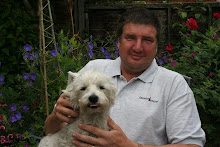Of course we are by no means the only 'bloggers' describing their small-holdering and gardening exploits on 'here' and as well as following Mentor Anne's fun and games with chickens, ducks and now a cute new kitten, we catch all the posts too by nearby 'one man band' lady, Colette O'N at her "Bealtaine Cottage" site not far north of Boyle. Her website and blog are at
http://bealtainecottage.com/2013/05/31/a-walk-through-the-permaculture-gardens-of-bealtaine-cottage-on-the-last-day-of-bealtaine/
Her stories always carry a host of pictures, but she also allows a controlled succession of visitors to be shown around and we signed up for one such tour this morning. I did not take a camera but I hope I can do the place justice. In 3 acres from a very unpromising start - fields like ours, all cattle-poached, over grazed and full of rushes, she has, over the course of 9 years, created a superb wooded garden which is threaded with narrow, interwoven paths and small clearings. She has planted around 900 trees over the years (a couple every weekend, she joked) from self-seeds, cuttings, gifts, purchases of bare rooted saplings or 2-3 year old 'feathers'.
They are mainly indigenous species, all be it many are 'not supposed to grow in a bog' - beech and copper beech for example. There are alder, mountain ash, birches, ash, elders and buddlieas, no end of willows including many woven and pleached into archways and living hedges. There are many fruit trees too, both in the woodland and in a clearer 'orchard' area. Most of the trees are less than the 9 years old, though there are some fine gnarly old beasts which pre-date Colette and one which may mark an old grave site from some poor unfortunate who would not have been allowed to be buried in a Christian grave-yard. The over whelming feel is as of a proper mature broad-leaved woodland with its canopy layer (the trees), it's under-storey (plenty of currant bushes, flowering currant (Ribes)) and dogwoods and then a lush herb layer full of buttercup, grasses, docks, vetches, primroses and no end of surprises, but all seemingly in balance with no one 'thug' dominating. The main driving force of plant choices is to provide year round food for the bees, from the earliest flowering Ribes, through to late autumn Sedums.
By digging out a winding channel through a low point she has managed to create a beautiful little stream which flows as clear as gin through a few small dammed silt-ponds, a bigger silt pond and then a bigger pond which was buzzing and wriggling with life - tadpoles, newts, boatmen, whirligig beetles and much more. This has also part drained the surrounding land so that it is no longer the boggy, poached mess she 'inherited'.
There is also an 'edible area' (edible for herself and for the birds) packed with fruit, currants (Colette thinks she'll get 200 lbs of blackcurrants this year) and the poly tunnel which I have admired since seeing it one of her blog-posts; it has straw paths and stone path edges, and its bronze fennel. As well as a good range of herbs, this carries plants for which she is keeping seed, including a 'perennial' purple sprouting broccoli which still gives sprouts for eating and carries viable seed although it is 3 years old. I also noticed a ruby chard being allowed to run away to seed. She sends quite a bit of seed away, especially to Americans who are always hungry for flowering plants 'from home'.
The 'permaculture' thing comes into focus on the original and on-going efforts to create and improve soil, from the thin, boggy, rush infested, cattle-abused stuff inherited to the the rich, deeper, leaf-mulched, compost enriched growing medium Colette has now. She showed us one of the new bits, an orchard. She lays cardboard down on the existing surface without digging it over, to exclude light. She has a decent shredder and actually grows fast growing plants like laurel and dogwood in among the trees to provide for shredded material. The cardboard is covered with shreddings, with straw from the poly tunnel paths, with compost and with clippings, bits of bramble and nettle and anything else which is bio degradable. This gets a soil, of sorts, going. It is then a fast track to getting trees established so that the trees can drop leaves and the whole cycle starts to build up a momentum of its own. The Ribes plants which will create the under-storey were already parked among the new fruit trees 'in waiting' (as it were) and there was even the start of a willow arbor for when the permaculture crept over that far and Colette could sit and look back at the orchard.
It was a very enjoyable and inspirational visit. Thank you very much, Colette, for that. As with all these garden visits, you don't come away wanting to copy every last thing and produce a Bealtaine 'clone' but you note the ideas down and keep them in your back pocket to add to other ideas you have seen at other gardens, and translate them into your own site. We do not need to do the soil-creation so much - we have 18" of pretty good stuff. But we did bring away the '3 layers woodland' idea and the notion that you can have currant bushes and a herb-rich layer under your fruit trees. We love that creeping buttercup is perfectly good as a herb in a mixture and doesn't need mowing, rooting out or eradicating where ever it appears. We love that you can save seed, so keep a few chard or broccoli plants and some bronze fennel. We love the idea of doing a few trees each weekend and always having some seedlings or cuttings on the go. We liked the hot and cold composting. We loved the idea of scrabbling up straw from the poly tunnel beds to add mulch to another bed. We particularly liked that this is a long term thing. Gardens, like Rome, are not built in a day and we can now look forward to 9 years and more of consolidation and improvement.
Thank you, Colette, for a brilliant day and a rake of good ideas to bring home.
Friday, 7 June 2013
A Visit to Bealtaine Cottage
Labels:
Bealtaine Cottage,
Bees,
blackcurrants,
bloggers,
Colette O'N,
Mentor Anne,
pleached,
Ribes,
Sedum,
Shredder
Subscribe to:
Post Comments (Atom)


1 comment:
Absolutely superb piece of writing...thank you Matt! Garden journalism at it's best!
Post a Comment